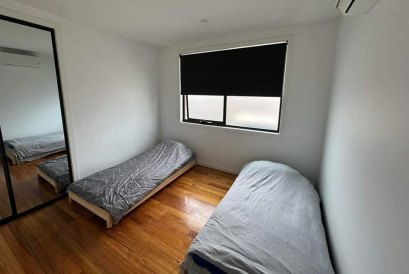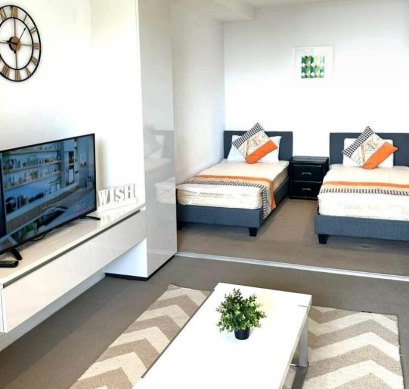This was published 1 year ago
We’re at the ‘$280 for a single bed in a shared room’ stage of the rental crisis
By Jim Malo and Bianca Hall
Landlords are advertising single beds for rent in shared rooms and cramming more than a dozen people into one house, exposing the desperate measures some Melburnians are being forced to take to find a home.
Such rooming house-style arrangements fall into a legal grey area and open people up to a heightened risk of exploitation, experts say. The listings are often targeted at international students, with several advertisements emphasising a preference for applications from “girls” or “ladies”.

Landlords are increasingly listing single beds for rent in Melbourne, with strangers forced to share a bedroom.Credit: Facebook
An ad for an apartment in Lonsdale Street sought four tenants to rent single beds in a modestly sized but well-appointed two-bedroom apartment for $280 a week – plus $750 in bond. It offered a $10 a week discount for a room with no window.
“If you want to move out of the house, you have to find someone else instead of yourself and let us know,” the ad stated.
Experts are warning anyone considering applying for a shared-room tenancy to be wary.
Tenants Victoria lead community education lawyer Ben Cording said these tenancy arrangements created an environment that was ripe for exploitation.

This two-bedroom apartment is advertised for $280 per week, per person: with a $10 discount for a room with no window.Credit: Facebook
“When you see ads like that, people really don’t know what they’re getting,” he said. “If people are just saying, ‘Pay me some money and come and share my bedroom’, that can be kind of concerning.
“All of a sudden [the tenants] have this person who has massive control of their life.”
Cording said the most precarious situations arose when tenants moved in without signing an official lease.
In this case, the tenant could be considered a “licensee” and have few clearly defined rights – most of which are derived from contract law, Cording said.
Resolving any disputes could require going to the magistrates’ court, as licensees don’t have access to VCAT. This arrangement isn’t illegal, but is considered a legal grey area.
Renting and Housing Union secretary Harry Millward said a renter had recently approached the organisation with a complaint about a landlord operating this type of share house.
Public listings data shows the property is a 13-bedroom house, which last changed hands in 2021. The company leasing the property to tenants does not appear on the state government’s rooming house register.
It is illegal to run an unregistered rooming house. The Sunday Age has chosen not to list the address or name the business to protect the tenant’s identity.
“They were piling 14 people into one house and charging them $340 per week, in rancid conditions,” he said. “You tell me, is that a scam? I would call that a scam.”
Millward said he had been approached by the tenant because the landlord had claimed he was in arrears for the month, despite previously collecting rent weekly.
He said the tenant did not speak fluent English and had struggled to secure other housing. He found the listing on Fairy Floss Real Estate, a popular Facebook group for finding share houses and existing rentals.
“If we look at the rental crisis, people are desperate. Desperate people will take whatever they can to survive,” he said.
“When people are in poverty conditions, it makes it so people won’t push back on those conditions.
“You know how they say making drugs illegal creates a black market? Making housing inaccessible creates a black market. The broad answer is to make housing accessible.”
Legal methods of leasing individual rooms include using a licensed rooming house, through a sublease agreed to by the owner, or by adding a tenant to the primary lease. These options came with risks, Cording said, but all carried protection under the Residential Tenancies Act.
Real Estate Institute of Victoria president Jake Caine said an unprecedented set of circumstances last year had led to a crunch in the property market, with overseas migration – including international students – returning in numbers and surging interest rates and property prices.
”There’s the often-cited expression of us being 250,000 dwellings short across Australia for the number of people living here,” he said.
Caine said leases were one of the strongest legal documents in the Victorian legislative environment, giving renters broad protections.
But if people advertising rooms – or beds in rooms – were themselves leaseholders, they could find themselves in breach of their lease for subletting, he said.
“It’s very dangerous territory for anyone even considering it. I completely understand in the economic context we’re in, why someone might go, ‘Look, I’d love to bring in a roommate and minimise the cost of the rent’, but it’s very precarious legally.”
Caine said a sustained social housing building program was the only way to address housing affordability and the lack of housing stock more broadly.
“In the ’50s we built across Australia 15,500 social homes per year – since 2000, we’ve averaged out to the thousands,” he said.
“We’re a much bigger, much richer, much more populous country today than we were in the ’50s and our migration level last year was lower than that boom post-WWII.
“If we had’ve built social houses at the rate that we built in the ’50s, over the past 23 or 24 years, we wouldn’t have the shortfall right now and we wouldn’t be in this situation.”
Start the day with a summary of the day’s most important and interesting stories, analysis and insights. Sign up for our Morning Edition newsletter.